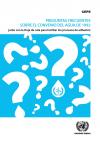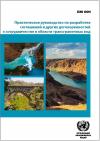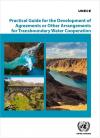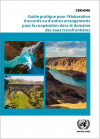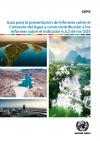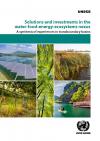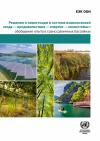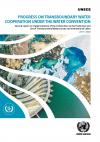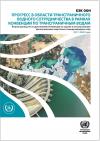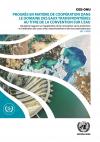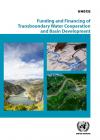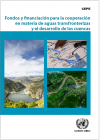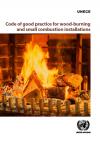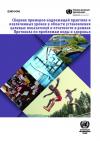Publications
Displaying Results 41 - 60 of 609
- Español
El Convenio sobre la Protección y Utilización de los Cursos de Agua Transfronterizos y de los Lagos Internacionales (Convenio del Agua) se adoptó en 1992 y entró en vigor en 1996. Diseñado como un instrumento regional, en 2003 el Convenio del Agua se enmendó para permitir la adhesión de países situados fuera de la región de la CEPE. Desde 2016 todos los Estados miembros de las Naciones Unidas
- Pусский
Разработка трансграничных соглашений и создание совместных органов являются ключевым обязательством прибрежных Сторон согласно Конвенции по охране и
использованию трансграничных водотоков и международных озер («Конвенция по трансграничным водам 1992 года»). Однако отчетность в рамках Конвенции по трансграничным водам 1992 года и по показателю 6.5.2 ЦУР, который измеряет наличие действующих
- English
More often than not, transboundary waters can be better governed via an agreement or other arrangement which typically applies to both, surface and groundwaters.
Just how can countries and other stakeholders of a shared water basin work towards an effective, adaptable and sustainable agreement? What do they need to consider in the design and drafting phase of such an agreement? Once in place, how
- Français
L’élaboration d’accords transfrontières et la création d’organes communs constituent une obligation essentielle pour les Parties riveraines de la Convention sur la protection et l’utilisation des cours d’eau transfrontières et des lacs internationaux (« Convention sur l’eau de 1992 »). Toutefois, les rapports établis au titre de la Convention sur l’eau de 1992 et sur l’indicateur 6.5.2 des ODD,
- Español
La introducción de un mecanismo de seguimiento de la aplicación del Convenio del Agua y la adopción del marco de los ODS (indicador 6.5.2 de los ODS) marcan un paso importante en el apoyo a la cooperación en materia de aguas transfronterizas. Esta Guía para la presentación de informes sobre el Convenio del Agua y como contribución a los informes sobre el indicador 6.5.2 de los ODS se elaboró como
- English
How can governments, other public and private actors learn about and better understand the water-energy-food-ecosystems nexus?
How can they use a ‘nexus approach’ to address the most pressing issues in transboundary water basins?
Last but not least, how can they design and implement ‘nexus’ solutions and investments that create synergies and provide transboundary benefits?
The new publication ‘
- Pусский
How can governments, other public and private actors learn about and better understand the water-energy-food-ecosystems nexus?
How can they use a ‘nexus approach’ to address the most pressing issues in transboundary water basins?
Last but not least, how can they design and implement ‘nexus’ solutions and investments that create synergies and provide transboundary benefits?
The new publication ‘
- Français
Comment les gouvernements et les autres acteurs publics et privés peuvent-ils apprendre et mieux comprendre le lien eau-énergie-alimentation-écosystèmes?
Comment peuvent-ils utiliser une "approche nexus" pour traiter les problèmes les plus urgents dans les bassins hydrographiques transfrontières?
Enfin, et surtout, comment peuvent-ils concevoir et mettre en œuvre des solutions et des
- English
The Convention on the Protection and Use of Transboundary Watercourses and International Lakes (Water Convention), hosted by the United Nations Economic Commission for Europe (ECE), requires Parties to prevent, control and reduce transboundary impact, use transboundary waters in a reasonable and equitable way and cooperate to ensure their sustainable management. Parties bordering the same
- Pусский
The Convention on the Protection and Use of Transboundary Watercourses and International Lakes (Water Convention), hosted by the United Nations Economic Commission for Europe (ECE), requires Parties to prevent, control and reduce transboundary impact, use transboundary waters in a reasonable and equitable way and cooperate to ensure their sustainable management. Parties bordering the same
- Français
La Convention sur la protection et l’utilisation des cours d’eau transfrontières et des lacs internationaux (Convention sur l’eau), dont le secrétariat est assuré par la Commission économique des Nations Unies pour l’Europe (CEE-ONU), exige des Parties qu’elles préviennent, maîtrisent et réduisent l’impact transfrontière, qu’elles utilisent les eaux transfrontières de manière raisonnable et
- English
More than 60 per cent of the world’s freshwater flow is shared between two or more riparian states. The sustainable and cooperative management of these transboundary water resources is crucial for access to water, sustainable development as well as regional stability and peace. However, many countries and basins struggle to identify and mobilize the needed funding for transboundary water
- Español
More than 60 per cent of the world’s freshwater flow is shared between two or more riparian states. The sustainable and cooperative management of these transboundary water resources is crucial for access to water, sustainable development as well as regional stability and peace. However, many countries and basins struggle to identify and mobilize the needed funding for transboundary water
- English
Domestic wood heating is a major source of emissions of particulate matter, including black carbon (BC), and organic pollutants, such as dioxins/furans, polycyclic aromatic hydrocarbons (PAHs) and benzo[a]pyrene (B(a)P), in the ECE region, resulting in poor local air quality conditions and significant negative effects on human health. The present document responds to the need to inform the
- English
Most of the world’s water resources are shared between countries. These transboundary waters create social, economic, environmental and political interdependencies that make cooperation a precondition to sustainable development and peace. SDG indicator 6.5.2 measures cooperation on both transboundary river and lake basins, and transboundary aquifers. In this second report on SDG indicator 6.5.2,
- العربية
Most of the world’s water resources are shared between countries. These transboundary waters create social, economic, environmental and political interdependencies that make cooperation a precondition to sustainable development and peace. SDG indicator 6.5.2 measures cooperation on both transboundary river and lake basins, and transboundary aquifers. In this second report on SDG indicator 6.5.2,
- Pусский
Most of the world’s water resources are shared between countries. These transboundary waters create social, economic, environmental and political interdependencies that make cooperation a precondition to sustainable development and peace. SDG indicator 6.5.2 measures cooperation on both transboundary river and lake basins, and transboundary aquifers. In this second report on SDG indicator 6.5.2,
- Français
La majorité des ressources mondiales en eau sont partagées entre les pays. Ces eaux transfrontières créent des interdépendances sociales, économiques, environnementales et politiques qui font de la coopération une condition préalable au développement durable et à la consolidation de la paix. L’indicateur 6.5.2 des ODD mesure la coopération relative aux bassins hydrographiques et aux aquifères
- Español
La mayoría de los recursos hídricos del mundo son compartidos entre varios países. Las aguas transfronterizas generan interdependencias políticas, sociales, económicas y ambientales que hacen de la cooperación en materia de aguas transfronterizas una condición previa para el desarrollo sostenible y la paz. Mediante el indicador 6.5.2 de los ODS se mide la cooperación transfronteriza tanto en las
- Pусский
The objective of the Collection of good practices and lessons learned on target setting and reporting under the Protocol on Water and Health is to provide concrete advice to countries planning to embark on the process of setting, revising or implementing targets, and reporting on the progress achieved in accordance with the Protocol.
In 2010,


